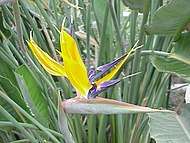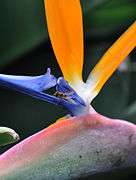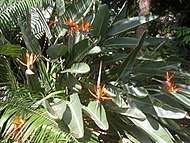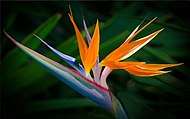Strelitzia reginae
Strelitzia reginae, commonly known as the crane flower or bird of paradise,[3] is a species of flowering plant indigenous to South Africa. An evergreen perennial, it is widely cultivated for its dramatic flowers. In temperate areas it is a popular houseplant.
| Strelitzia reginae | |
|---|---|
| Flower | |
| Scientific classification | |
| Kingdom: | Plantae |
| Clade: | Tracheophytes |
| Clade: | Angiosperms |
| Clade: | Monocots |
| Clade: | Commelinids |
| Order: | Zingiberales |
| Family: | Strelitziaceae |
| Genus: | Strelitzia |
| Species: | S. reginae |
| Binomial name | |
| Strelitzia reginae | |
Taxonomy
Sir Joseph Banks described the species in 1788.[2] The specific epithet reginae means “of the queen”, and commemorates the British queen Charlotte of Mecklenburg-Strelitz, wife of George III.[3] Common names such as “crane flower” and “bird of paradise” reference the open flower’s resemblance to the head and beak of a colourful exotic bird.[4]
Genetic analysis reveals Strelitzia juncea has been shown to be genetically nested within S. reginae. It is possibly a mutation that is in the process of speciating.[5]
Description
The plant grows to 2 m (6.6 ft) tall, with large, strong leaves 25–70 cm (9.8–27.6 in) long and 10–30 cm (3.9–11.8 in) broad, produced on petioles up to 1 m (39 in) long. The leaves are evergreen and arranged in two ranks, making a fan-shaped crown. The flowers stand above the foliage at the tips of long stalks. The hard, beak-like sheath from which the flower emerges is termed the spathe. This is placed perpendicular to the stem, which gives it the appearance of a bird's head and beak; it makes a durable perch for holding the sunbirds which pollinate the flowers. The flowers, which emerge one at a time from the spathe, consist of three brilliant orange sepals and three purplish-blue or white petals. Two of the blue or white petals are joined together to form an arrow-like nectary. When the sunbirds sit to drink the nectar, the petals open to cover their feet in pollen.[6]
Cultivation and uses
Strelitzia reginae is very popular as an ornamental plant. It was first introduced to Britain in 1773, when it was grown at the Royal Botanic Gardens, Kew. Since then, it has been widely introduced around the world, including the Americas and Australia, growing well in any area that is sunny and warm. In the United States, Florida and California are the main areas of cultivation, due to their warm climate. It is a common ornamental plant in Southern California, and has been chosen as the Official Flower of the City of Los Angeles.[7][8]
In the UK it is normally grown under glass, in a cool sunny position such as a greenhouse or conservatory, as it does not tolerate temperatures below 10 °C (50 °F). However it may be placed outside during the summer months. It has gained the Royal Horticultural Society's Award of Garden Merit.[9][10]
It is a low-maintenance plant that is easy to grow in the garden; it is fairly tolerant of soil conditions and needs little water once established. If cared for well, they will flower several times in a year. They will thrive in rich loamy soil, especially when they get plenty of water throughout the year. They do well in full sun to semi-shade and respond well to regular feeding with a controlled release fertiliser and compost. They are sensitive to cold and need to be sheltered from frost, as it can damage the flowers and leaves.
Strelitzia reginae is slow-growing and will not bloom until three to five years have passed since germination (though it can exceptionally flower at two years).[11] It flowers only when properly established and division of the plant may affect flowering patterns. The flowers are, however, quite long-lasting once they appear. Peak flowering is in the winter and early spring. There is a yellow-flowered cultivar of this plant known as ‘Mandela's Gold’.[12]
It is propagated by seed or division.
Allergenic potential
Bird-of-paradise plants have an OPALS allergy scale rating of 1, and are considered "allergy-fighting"; they produce no airborne pollen.[13]
Gallery
 var. taki Hort
var. taki Hort closeup, Jardim Botânico da Madeira
closeup, Jardim Botânico da Madeira
 'Mandela's Gold', Kirstenbosch National Botanical Garden, Cape Town
'Mandela's Gold', Kirstenbosch National Botanical Garden, Cape Town Kolkata, India
Kolkata, India
References
- "Strelitzia reginae". Germplasm Resources Information Network (GRIN). Agricultural Research Service (ARS), United States Department of Agriculture (USDA). Retrieved 2008-03-10.
- "Strelitzia reginae". World Checklist of Selected Plant Families. Royal Botanic Gardens, Kew. Retrieved 2017-08-03.
- "Strelitzia reginae". PlantZAfrica.com. Retrieved 24 November 2018.
- "Plants of the World Online:Strelitzia reginae Banks". Kew Science. Retrieved 24 November 2018.
- Cron, Glynis V.; Pirone, Cary; Bartlett, Madelaine; Kress, W. John; Specht, Chelsea (2012). "Phylogenetic Relationships and Evolution in the Strelitziaceae (Zingiberales)". Systematic Botany. 37 (3): 606–619. doi:10.1600/036364412X648562.
- Gibbs Russell, G. E., W. G. M. Welman, E. Retief, K. L. Immelman, G. Germishuizen, B. J. Pienaar, M. Van Wyk & A. Nicholas. 1987. List of species of southern African plants. Memoirs of the Botanical Survey of South Africa 2(1–2): 1–152(pt. 1), 1–270(pt. 2).
- Nichols, Chris (19 October 2015). "Ask Chris: When Did the Bird of Paradise Become the Official Flower of L.A.?". lamag.com. Retrieved 21 May 2017.
- "Get to know the official flower and tree of Los Angeles". dailynews.com. 20 March 2014. Retrieved 21 May 2017.
- "RHS Plant Selector - Strelitzia reginae". Retrieved 4 June 2013.
- "AGM Plants - Ornamental" (PDF). Royal Horticultural Society. July 2017. p. 99. Retrieved 21 November 2018.
- Joffe, P. Easy Guide to Indigenous Shrubs, Briza Publications, 2003 ISBN 1-875093-40-0
- "Strelitzia reginae 'Mandela's Gold'". pza.sanbi.org. Retrieved 21 May 2017.
- Ogren, Thomas (2015). The Allergy-Fighting Garden. Berkeley, CA: Ten Speed Press. p. 200. ISBN 978-1-60774-491-7.
External links
![]()
![]()